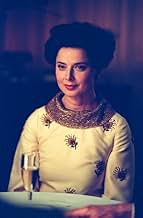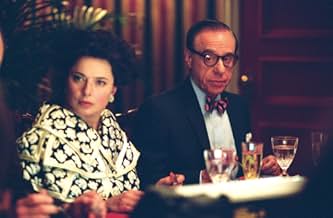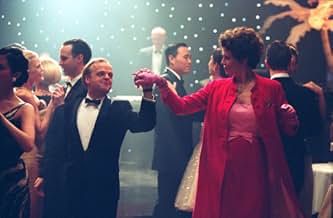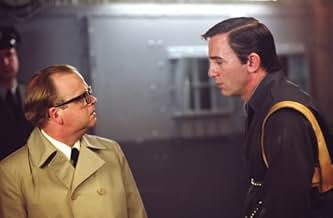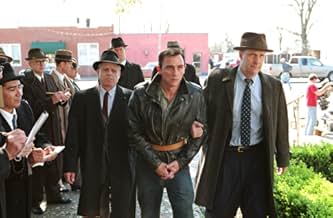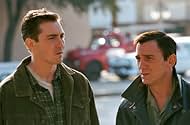While researching his novel "In Cold Blood", Truman Capote develops a close relationship with convicted murderers Dick Hickock and Perry Smith.While researching his novel "In Cold Blood", Truman Capote develops a close relationship with convicted murderers Dick Hickock and Perry Smith.While researching his novel "In Cold Blood", Truman Capote develops a close relationship with convicted murderers Dick Hickock and Perry Smith.
- Director
- Writers
- Stars
- Awards
- 3 wins & 2 nominations total
Frank G. Curcio
- William Shawn
- (as Frank Curcio)
Terri Merritt Bennett
- D.A.'s Secretary
- (as Terri Bennett)
- Director
- Writers
- All cast & crew
- Production, box office & more at IMDbPro
Featured reviews
When I saw "Capote" I was really impressed by the presentation of the story and the quality of the acting. When I saw "Infamous" today, I was caught up with the story in a way I had not been before. It was closer to the experience when I read the book many,many years ago. "In Cold Blood" is about killing human beings, and I believe that it is no more right for cold blooded murders to do it than for me do do it as a member of society that authorizes the death penalty. I believe that the film as well as the book makes people think about this issue The cast was superb, and I said the same about the earlier rendition, but this time the characters were fully developed and believable under the circumstances. I had been impressed before, but this film is different from the last--it is more emotional, more detailed in rendition of the characters, and more interested in showing not just the destruction of Truman Capote, but in sharing the ideas that he expressed in "In Cold Blood".
When I was growing up (I am 62 now) I recall that I did not like Capote when I saw him on talk shows repeatedly. I really knew nothing of gay culture or what even that meant at the time, so it had nothing to do with the sexual orientation. It had to do with the ego that was constantly expressed and realted to nothing that I really cared about.
But what was incredibly important to me then and now is that we can lose track of the fact that we are all human beings, a point that was stressed in the film. Killers may be killers, but they are us, in a way, filled with some of the same ambitions, hates, emotions that most of us can control. What separates us from them might not be very much, so why do we need to kill them as they jailed their victims? It is easy to kill, but not so easy to try to understand. This film hits an emotional level that the previous film did not. I am pleased that it ultimately was made. I am also pleased that the quality of the performances, the writing and most especially the direction, were so superb. Watch the scene where the farmer speaks only to Harper Lee and not Capote. It is an incredible monologue, but the circumstances are noted.
When I was growing up (I am 62 now) I recall that I did not like Capote when I saw him on talk shows repeatedly. I really knew nothing of gay culture or what even that meant at the time, so it had nothing to do with the sexual orientation. It had to do with the ego that was constantly expressed and realted to nothing that I really cared about.
But what was incredibly important to me then and now is that we can lose track of the fact that we are all human beings, a point that was stressed in the film. Killers may be killers, but they are us, in a way, filled with some of the same ambitions, hates, emotions that most of us can control. What separates us from them might not be very much, so why do we need to kill them as they jailed their victims? It is easy to kill, but not so easy to try to understand. This film hits an emotional level that the previous film did not. I am pleased that it ultimately was made. I am also pleased that the quality of the performances, the writing and most especially the direction, were so superb. Watch the scene where the farmer speaks only to Harper Lee and not Capote. It is an incredible monologue, but the circumstances are noted.
Writer-director Douglas McGrath's new film about Truman Capote and the creation of his most famous book, "In Cold Blood," is full of contradictions and contrasts when compared with its predecessor, the 2005 film "Capote," that covers the same five-year period. Perhaps this is fitting. There may be some justice in the fact that these two filmic accounts of how Capote researched material for his magnum opus disagree significantly in emphasis and purported events.
After all, Capote used fictional methods to embellish - some might say falsify - his journalistic reportage on the murders of the Clutter family in Holcomb, Kansas, in 1959. If the screenplays for these two films tell differing stories of Capote's experience, does it matter if one is closer to the truth than the other? Or that we can't be sure - indeed, will never know - what actually occurred during many of the encounters between Capote, who was famous for fabricating yarns about his own life, and others out in Holcomb so long ago?
The films are each based on separate biographical accounts. "Capote" was adapted from Gerald Clarke's 1988 biography bearing the same title. "Infamous" is based on George Plimpton's 1997 book, "Truman Capote: In Which Various Friends, Enemies, Acquaintances and Detractors Recall His Turbulent Career," an account presented as a sequence of quotes from interviews Plimpton conducted with more than 150 people who knew Capote.
"Infamous" is far kinder to Capote than the earlier film, portraying him as quite clearly enamored of the killer Perry Smith (an ardor fully requited by Smith) and deeply anguished when Smith is executed. "Capote" depicts the author as more conniving, manipulative and disingenuous, willing to say or do anything to get Smith to spill his story, and withholding of possible interventions he - Capote - might have made to further delay or avert the executions of Smith and his accomplice, Dick Hickock.
In "Capote" the author's erotic attraction to Smith is more muted, hinted at, not acted upon. Indeed, "Infamous" is in general more explicit and direct in its portrayals, often more graphic if you will, than "Capote." Besides kisses and embraces between Capote and Smith, other scenes not covered in "Capote" include moments of violence when Smith virtually attacks Capote in his cell. We also witness the murders of the Clutters and Hickock's execution by hanging, including the protracted interval during which his body remains vertically suspended until he is finally declared dead by the attending physician.
There are other differences, for example, Capote's bid to establish rapport with the local Sheriff, Alvin Dewey, is depicted as much more problematic in "Infamous" than in "Capote." A plus for "Infamous" is its attention to Capote's relationships with a covey of New York society women known as his "swans," their adulation of him, his ability to coax them into sharing their secrets for his later use as gossip fodder. But, again, McGrath employs a graphic style to introduce us to these women, and several others in Capote's social circle, namely, the use of large white name titles as we first meet each, documentary style.
I find it impossible to resist comparing acting performances in the two productions. The more nuanced, oblique style of "Capote" is realized not only through its general avoidance of graphic scenes but in the greater subtlety of the two central actors' performances. In "Infamous," the English character actor Toby Jones physically resembles Capote more than does his counterpart in "Capote," Philip Seymour Hoffman. Both actors offer convincing personifications in voice and style. But I lean toward Hoffman's as the more complex, accomplished turn, characterized by critic Shawn Levy as "note-perfect." Levy goes on, "The wheezy laugh, the pain of work, the prying nature, the cold eye, the self-obsession, the ability to perform and ingratiate and wheedle - it's Capote you're watching up there "
The brilliant English actor Daniel Craig gives a forceful, indeed galvanizing, performance as the killer, Perry Smith. But I think his mercurial, intensely melodramatic interpretation of his character is less convincing than his counterpart in "Capote," Clifton Collins, Jr. Collins's Smith is more introverted, by turns chilling or vulnerable to be sure, but for the most part quietly opaque, subdued, soulfully melancholic. For me this depiction is the more compelling and believable.
Other key performances are well delivered in both films: Catherine Keener ("Capote") and Sandra Bullock ("Infamous") as Harper Lee, though I liked Ms. Bullock's turn better; Chris Cooper ("Capote") and Jeff Daniels ("Infamous") as Sheriff Dewey. Capote's "swans" in "Infamous" are delightfully played by Sigourney Weaver, Juliet Stevenson, Hope Davis and Isabella Rossellini.
So we have two versions of the story of Capote's adventures in Kansas: both strong films, well cast, worthwhile. I think "Capote" is the better film because of its more subtle approach and the performances of the two central actors. As for realism in the interpretation of Truman Capote's character, perhaps the two portrayals taken together triangulate on the "real" Capote, a complex, convoluted personality as worthy of our sympathy as our contempt. My grades: 8/10 (high B+) (Seen on 10/10/06)
After all, Capote used fictional methods to embellish - some might say falsify - his journalistic reportage on the murders of the Clutter family in Holcomb, Kansas, in 1959. If the screenplays for these two films tell differing stories of Capote's experience, does it matter if one is closer to the truth than the other? Or that we can't be sure - indeed, will never know - what actually occurred during many of the encounters between Capote, who was famous for fabricating yarns about his own life, and others out in Holcomb so long ago?
The films are each based on separate biographical accounts. "Capote" was adapted from Gerald Clarke's 1988 biography bearing the same title. "Infamous" is based on George Plimpton's 1997 book, "Truman Capote: In Which Various Friends, Enemies, Acquaintances and Detractors Recall His Turbulent Career," an account presented as a sequence of quotes from interviews Plimpton conducted with more than 150 people who knew Capote.
"Infamous" is far kinder to Capote than the earlier film, portraying him as quite clearly enamored of the killer Perry Smith (an ardor fully requited by Smith) and deeply anguished when Smith is executed. "Capote" depicts the author as more conniving, manipulative and disingenuous, willing to say or do anything to get Smith to spill his story, and withholding of possible interventions he - Capote - might have made to further delay or avert the executions of Smith and his accomplice, Dick Hickock.
In "Capote" the author's erotic attraction to Smith is more muted, hinted at, not acted upon. Indeed, "Infamous" is in general more explicit and direct in its portrayals, often more graphic if you will, than "Capote." Besides kisses and embraces between Capote and Smith, other scenes not covered in "Capote" include moments of violence when Smith virtually attacks Capote in his cell. We also witness the murders of the Clutters and Hickock's execution by hanging, including the protracted interval during which his body remains vertically suspended until he is finally declared dead by the attending physician.
There are other differences, for example, Capote's bid to establish rapport with the local Sheriff, Alvin Dewey, is depicted as much more problematic in "Infamous" than in "Capote." A plus for "Infamous" is its attention to Capote's relationships with a covey of New York society women known as his "swans," their adulation of him, his ability to coax them into sharing their secrets for his later use as gossip fodder. But, again, McGrath employs a graphic style to introduce us to these women, and several others in Capote's social circle, namely, the use of large white name titles as we first meet each, documentary style.
I find it impossible to resist comparing acting performances in the two productions. The more nuanced, oblique style of "Capote" is realized not only through its general avoidance of graphic scenes but in the greater subtlety of the two central actors' performances. In "Infamous," the English character actor Toby Jones physically resembles Capote more than does his counterpart in "Capote," Philip Seymour Hoffman. Both actors offer convincing personifications in voice and style. But I lean toward Hoffman's as the more complex, accomplished turn, characterized by critic Shawn Levy as "note-perfect." Levy goes on, "The wheezy laugh, the pain of work, the prying nature, the cold eye, the self-obsession, the ability to perform and ingratiate and wheedle - it's Capote you're watching up there "
The brilliant English actor Daniel Craig gives a forceful, indeed galvanizing, performance as the killer, Perry Smith. But I think his mercurial, intensely melodramatic interpretation of his character is less convincing than his counterpart in "Capote," Clifton Collins, Jr. Collins's Smith is more introverted, by turns chilling or vulnerable to be sure, but for the most part quietly opaque, subdued, soulfully melancholic. For me this depiction is the more compelling and believable.
Other key performances are well delivered in both films: Catherine Keener ("Capote") and Sandra Bullock ("Infamous") as Harper Lee, though I liked Ms. Bullock's turn better; Chris Cooper ("Capote") and Jeff Daniels ("Infamous") as Sheriff Dewey. Capote's "swans" in "Infamous" are delightfully played by Sigourney Weaver, Juliet Stevenson, Hope Davis and Isabella Rossellini.
So we have two versions of the story of Capote's adventures in Kansas: both strong films, well cast, worthwhile. I think "Capote" is the better film because of its more subtle approach and the performances of the two central actors. As for realism in the interpretation of Truman Capote's character, perhaps the two portrayals taken together triangulate on the "real" Capote, a complex, convoluted personality as worthy of our sympathy as our contempt. My grades: 8/10 (high B+) (Seen on 10/10/06)
"INFAMOUS" ~~ THE OTHER BETTER CAPOTE ... Directed by Douglas McGrath who also wrote the screenplay for Woody Allen's "Bullets Over Broadway" (1994) and directed Paltrow in Jane Austen's "Emma", 1996. Starring Toby Jones as Truman Capote -- one of those rare cases where the actor did not "play" the role but completely entered the skin of the real life character in question. Incredibly "Infamous" was on last night on Hungarian TV, Dubbed into Hungarian but I watched it anyway, for the body language and Production values. And the general feeling of the movie. I had forgotten what an important role a deglamourised Sandra Bullock had in this picture as Capote's constant companion throughout. But the fact that this major Hollywood star was content to take a supporting role to an unknown British actor is a real mark of her professionalism. Interestingly, she smokes in just about every scene she's in, which I assume was just for the requirements of the picture. Toby Jones is head and shoulders better than Seymour Hoffman was in the role, Besides the fact that he is a dead ringer for minuscule real life Capote whereas Bulky Seymour wasn't even close. If there were anything resembling integrity In the Hollywood film world, Jones should have been a walkaway for best actor in 2007 and Bullock would have been a very worthy candidate for Best Supporting actress, female -- Come to think of it, they oughta have a special slot for "Best supporting role by a star leading actor/actress willing to take a back seat" in a quality picture.
I saw "Infamous" at the 2006 Venice film festival and recognized it then as an unsung masterpiece, far far better than the Hoffman caricature earlier the same year. It opens with an incredible turn by Gwyneth Paltrow in a long white gown as Peggy Lee doing the old standard "This must Be Love" -- but she is so touched by the inherent sadness of the song that she breaks down in the middle and has to stop. What an opener! ~ possibly the best single scene Paltrow has ever done. Which sets the tone for everything to come.
A series of interviews follows with celebrity contemporaries of Capote speaking to the camera and identified by name with on screen titles which gives the picture a documentary feel, but the name celebrities are themselves celebrity actors such as Sigourney Weaver and especially, Peter Bogdanovich as Bennet Cerf. I think this is definitely one of the very best pictures of the Decade, 2000- 2010, and one that I would like to own so I could watch it over and over. And don't forget Daniel Craig (later to be Dubble 007!) as death row killer Perry Smith who Capote falls in love with! The prison interviews are filmed in a kind of chiaro-oscuro and the 1959 Period atmosphere is unobtrusively authentic-- without parading collectors vintage cars across the screen in every outdoor scene.
"Infamous", 2006, is a true gem in every respect but fell between the cracks because it was overshadowed by the hullabaloo over the distinctly inferior Sony Pictures production -- a classic case of the triumph of publicity over Quality.
I saw "Infamous" at the 2006 Venice film festival and recognized it then as an unsung masterpiece, far far better than the Hoffman caricature earlier the same year. It opens with an incredible turn by Gwyneth Paltrow in a long white gown as Peggy Lee doing the old standard "This must Be Love" -- but she is so touched by the inherent sadness of the song that she breaks down in the middle and has to stop. What an opener! ~ possibly the best single scene Paltrow has ever done. Which sets the tone for everything to come.
A series of interviews follows with celebrity contemporaries of Capote speaking to the camera and identified by name with on screen titles which gives the picture a documentary feel, but the name celebrities are themselves celebrity actors such as Sigourney Weaver and especially, Peter Bogdanovich as Bennet Cerf. I think this is definitely one of the very best pictures of the Decade, 2000- 2010, and one that I would like to own so I could watch it over and over. And don't forget Daniel Craig (later to be Dubble 007!) as death row killer Perry Smith who Capote falls in love with! The prison interviews are filmed in a kind of chiaro-oscuro and the 1959 Period atmosphere is unobtrusively authentic-- without parading collectors vintage cars across the screen in every outdoor scene.
"Infamous", 2006, is a true gem in every respect but fell between the cracks because it was overshadowed by the hullabaloo over the distinctly inferior Sony Pictures production -- a classic case of the triumph of publicity over Quality.
Infamous has a difficult comparison with the earlier "Capote." Still it is a different view of the same story and characters and is written with more emphasis on the perspectives of those who knew, or thought they knew, Capote. Toby Jones may not fully match the nuanced performance of Philip Seymour Hoffman but he does, possibly, a better imitation of Capote. Infamous has a better known cast of supporting players and they do a creditable job. Sandra Bullock's Harper Lee isn't the quite same as that portrayed so well by Catherine Keener in "Capote" but her character blends perfectly with the tone of "Infamous." Daniel Craig adds another fine acting turn as the "In Cold Blood" killer who receives the most attention. Even Gwyneth Paltrow makes an excellent impression in a brief opening scene as, apparently, singer Peggy Lee. (In the showing I saw, she was introduced as "Kitty Dean???") I wondered why another version of this story was filmed and it may not do well after the success of "Capote" but I was surprisingly entertained and intrigued by this movie.
10dglink
Truman Capote may be unique among recent celebrities to have two excellent films made about his life. Just a year after Phillip Seymour Hoffman's mesmerizing performance in "Capote," Toby Jones does a fine, if more expected, impersonation of the author of "In Cold Blood" and "Breakfast at Tiffany's." With the razor sharp wit and effete mannerisms more focused than they were in "Capote," Jones, in Douglas McGrath's "Infamous," is a more vulnerable Truman and is unquestionably in love with one of the Clutter family killers, Perry Smith. Although ostensibly a drama, "Infamous" is replete with Capote's celebrated wit, and the one-liners, which are often sexual in nature, are welcome relief from the heavier scenes.
However, "Infamous" is at heart a love story, or rather two, love stories. The first romance is between Truman Capote and his coterie of largely female socialite friends, with whom he gossips and parties and self adulates. The second, much deeper love story, between Capote and Smith, begins as Capote explores Smith's background and family history. Although their relationship, which the film implies was more than platonic, develops within the confines of prison, the two men connect through similar personal tragedies in their childhoods. Smith, well played by Daniel Craig, was at least bisexual or even gay, according to McGrath's screenplay. Although a subliminal connection between the two killers was suggested in both the films "In Cold Blood" and "Capote," in this film Dick Hickock, Smith's partner in the Clutter killings, recognizes Perry's orientation and taunts him with it.
Although a bevy of well-known performers threatens to undercut the realism of the drama with a game of "isn't that so and so?," the acting rises above star cameos and blends seamlessly into the whole. In fact, the familiar faces aid in maintaining recognition of the parade of celebrities, such as Babs Paley, Gore Vidal, and Harper Lee that surrounded Capote in life. Borrowing a technique from Warren Beatty's "Reds," McGrath effectively uses witnesses that talk to the camera about Truman as though being interviewed at some later date. Surprisingly, these interview segments do not interrupt the flow of the drama and enhance rather than detract from the film's power.
And powerful it is. Although the execution scenes have been filmed twice before, Truman's parting from the killers and the actual hangings remain almost unbearable to watch. Although two films have preceded this one and related essentially the same story, "Infamous" stands as a worthy addition to what is now a trilogy on the Clutter family murders (1967's "In Cold Blood," 2005's "Capote," 2006's "Infamous"). Surprisingly, each film is equally engrossing and brings its own viewpoint to the story. Like different facets of a prism or a three-film version of "Rashomon," the tale of Truman Capote's reportage of the murders retains its fascination and the enigma of Capote's relationship with the killers. Rarely have three such powerful, outstanding films been made from the same subject matter.
However, "Infamous" is at heart a love story, or rather two, love stories. The first romance is between Truman Capote and his coterie of largely female socialite friends, with whom he gossips and parties and self adulates. The second, much deeper love story, between Capote and Smith, begins as Capote explores Smith's background and family history. Although their relationship, which the film implies was more than platonic, develops within the confines of prison, the two men connect through similar personal tragedies in their childhoods. Smith, well played by Daniel Craig, was at least bisexual or even gay, according to McGrath's screenplay. Although a subliminal connection between the two killers was suggested in both the films "In Cold Blood" and "Capote," in this film Dick Hickock, Smith's partner in the Clutter killings, recognizes Perry's orientation and taunts him with it.
Although a bevy of well-known performers threatens to undercut the realism of the drama with a game of "isn't that so and so?," the acting rises above star cameos and blends seamlessly into the whole. In fact, the familiar faces aid in maintaining recognition of the parade of celebrities, such as Babs Paley, Gore Vidal, and Harper Lee that surrounded Capote in life. Borrowing a technique from Warren Beatty's "Reds," McGrath effectively uses witnesses that talk to the camera about Truman as though being interviewed at some later date. Surprisingly, these interview segments do not interrupt the flow of the drama and enhance rather than detract from the film's power.
And powerful it is. Although the execution scenes have been filmed twice before, Truman's parting from the killers and the actual hangings remain almost unbearable to watch. Although two films have preceded this one and related essentially the same story, "Infamous" stands as a worthy addition to what is now a trilogy on the Clutter family murders (1967's "In Cold Blood," 2005's "Capote," 2006's "Infamous"). Surprisingly, each film is equally engrossing and brings its own viewpoint to the story. Like different facets of a prism or a three-film version of "Rashomon," the tale of Truman Capote's reportage of the murders retains its fascination and the enigma of Capote's relationship with the killers. Rarely have three such powerful, outstanding films been made from the same subject matter.
Did you know
- TriviaThis film appeared not long after the film Truman Capote (2005). While Infamous goes deeper into the background of the killers, Capote focuses intensely on the relationship between Capote and Smith. As such, the two films could be considered to be companion pieces.
- GoofsEarly in the movie Harper Lee and Capote order drinks in a Holcomb, Kansas restaurant. At the time of the movie's action, Kansas was dry as a bone. You couldn't buy a drink in a Kansas restaurant until state liquor laws began to change in the mid '80s.
- Quotes
Truman Capote: Imagine being told your work lacked kindness by a four-time killer!
- How long is Infamous?Powered by Alexa
Details
- Release date
- Country of origin
- Official site
- Language
- Also known as
- Infamous
- Filming locations
- Marlin, Texas, USA(Courthouse exterior and interior scenes)
- Production companies
- See more company credits at IMDbPro
Box office
- Budget
- $13,000,000 (estimated)
- Gross US & Canada
- $1,151,330
- Opening weekend US & Canada
- $452,966
- Oct 15, 2006
- Gross worldwide
- $2,689,799
- Runtime1 hour 50 minutes
- Color
- Sound mix
- Aspect ratio
- 1.85 : 1
Contribute to this page
Suggest an edit or add missing content

Top Gap
By what name was Scandaleusement célèbre (2006) officially released in India in English?
Answer



